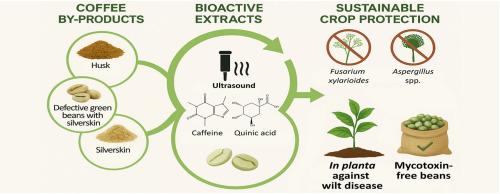Circular economy approach to coffee processing residue valorization: Bioactive by-product extracts for managing pre- and post-harvest fungal pathogens
IF 2.5
2区 农林科学
Q1 AGRONOMY
引用次数: 0
Abstract
The coffee industry generates a large amount of waste that is usually discarded, creating an environmental and economic problem. However, these by-products can be a valuable source of bioactive compounds with antimicrobial properties and present an opportunity for use in crop protection, either pre- or post-harvest. Following the principles of the circular economy, this study proposes the extraction and characterization of bioactive products from coffee by-products, as well as the evaluation of their antifungal activity against pathogens that affect coffee plants and/or stored coffee beans, such as Fusarium xylarioides, Aspergillus flavus, A. niger, and Penicillium verrucosum. In vitro activity assays demonstrate high antimicrobial activity of the husk, parchment, defective green beans with silverskin, and silverskin extracts, with minimum inhibitory concentrations ranging from 15.6 to 375 μg mL−1 against F. xylarioides, 31.2–1000 μg mL−1 against A. flavus, 62.5–1000 μg mL−1 against A. niger, and 62.5–1500 μg mL−1 against P. verrucosum, depending on the by-product extract used. The most effective extract, derived from silverskin, was evaluated for pre-harvest protection of coffee plants and demonstrated complete inhibition of F. xylarioides-induced tracheomycosis at 15.6 μg mL−1. In turn, a concentration of 62.5 μg mL−1 of the silverskin extract was sufficient to prevent fungal growth of A. flavus, A. niger, and P. verrucosum on coffee beans. This concentration also prevented mycotoxin production by A. flavus, while a higher concentration of 125 μg mL−1 was required to prevent aflatoxin production by A. niger. The reported findings support coffee by-products extracts as promising alternatives to synthetic fungicides, with the potential to improve the sustainability of the coffee industry.

咖啡加工残留物增值的循环经济方法:用于管理收获前和收获后真菌病原体的生物活性副产品提取物
咖啡工业产生了大量通常被丢弃的废物,造成了环境和经济问题。然而,这些副产品可能是具有抗菌特性的生物活性化合物的宝贵来源,并提供了在收获前或收获后用于作物保护的机会。遵循循环经济的原则,本研究提出了从咖啡副产品中提取和鉴定生物活性产品,以及评估其对影响咖啡植物和/或储存的咖啡豆的病原菌,如木镰刀菌、黄曲霉、黑曲霉和疣状青霉的抗真菌活性。体外活性分析表明,皮、羊皮纸、带银皮的缺陷青豆和银皮提取物具有较高的抑菌活性,对木质菌的最低抑菌浓度为15.6 ~ 375 μg mL - 1,对黄曲霉的最低抑菌浓度为31.2 ~ 1000 μg mL - 1,对黑曲霉的最低抑菌浓度为62.5 ~ 1000 μg mL - 1,对疣状霉的最低抑菌浓度为62.5 ~ 1500 μg mL - 1,这取决于所使用的副产物提取物。从银皮中提取的最有效提取物对咖啡树的采收前保护作用进行了评估,结果表明,15.6 μg mL−1的浓度对木毒菌诱导的气管真菌病有完全的抑制作用。结果表明,浓度为62.5 μg mL−1的银皮提取物足以抑制黄曲霉、黑曲霉和疣状霉在咖啡豆上的生长。该浓度对黄曲霉产生霉菌毒素也有抑制作用,而对黑曲霉产生黄曲霉毒素则需要125 μg mL−1的较高浓度。报告的研究结果支持咖啡副产品提取物作为合成杀菌剂的有希望的替代品,具有提高咖啡工业可持续性的潜力。
本文章由计算机程序翻译,如有差异,请以英文原文为准。
求助全文
约1分钟内获得全文
求助全文
来源期刊

Crop Protection
农林科学-农艺学
CiteScore
6.10
自引率
3.60%
发文量
200
审稿时长
29 days
期刊介绍:
The Editors of Crop Protection especially welcome papers describing an interdisciplinary approach showing how different control strategies can be integrated into practical pest management programs, covering high and low input agricultural systems worldwide. Crop Protection particularly emphasizes the practical aspects of control in the field and for protected crops, and includes work which may lead in the near future to more effective control. The journal does not duplicate the many existing excellent biological science journals, which deal mainly with the more fundamental aspects of plant pathology, applied zoology and weed science. Crop Protection covers all practical aspects of pest, disease and weed control, including the following topics:
-Abiotic damage-
Agronomic control methods-
Assessment of pest and disease damage-
Molecular methods for the detection and assessment of pests and diseases-
Biological control-
Biorational pesticides-
Control of animal pests of world crops-
Control of diseases of crop plants caused by microorganisms-
Control of weeds and integrated management-
Economic considerations-
Effects of plant growth regulators-
Environmental benefits of reduced pesticide use-
Environmental effects of pesticides-
Epidemiology of pests and diseases in relation to control-
GM Crops, and genetic engineering applications-
Importance and control of postharvest crop losses-
Integrated control-
Interrelationships and compatibility among different control strategies-
Invasive species as they relate to implications for crop protection-
Pesticide application methods-
Pest management-
Phytobiomes for pest and disease control-
Resistance management-
Sampling and monitoring schemes for diseases, nematodes, pests and weeds.
 求助内容:
求助内容: 应助结果提醒方式:
应助结果提醒方式:


